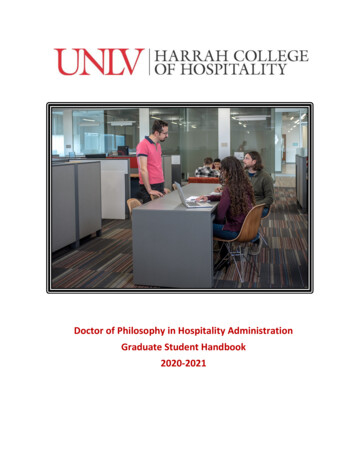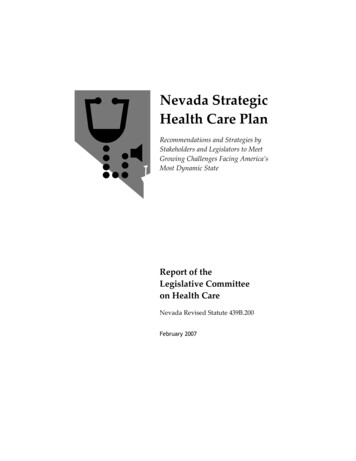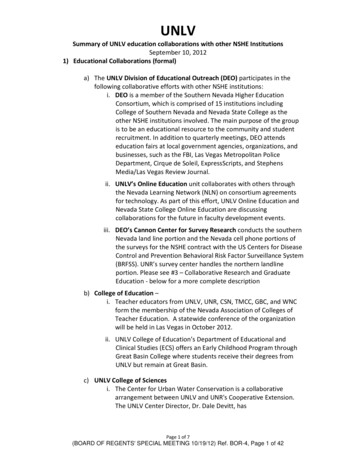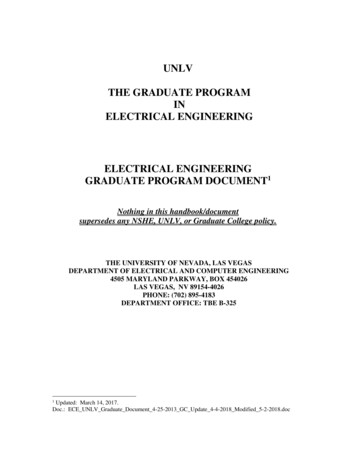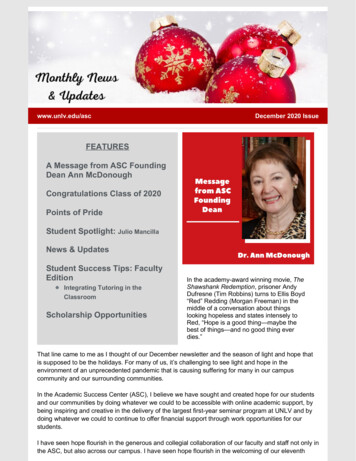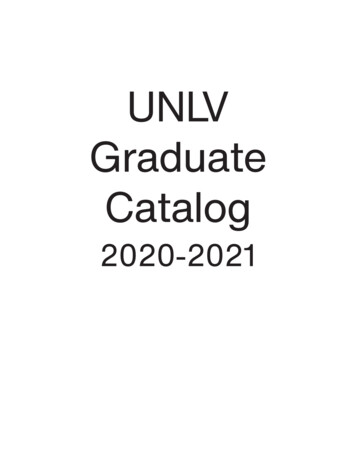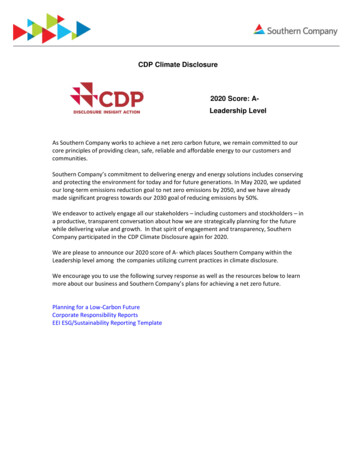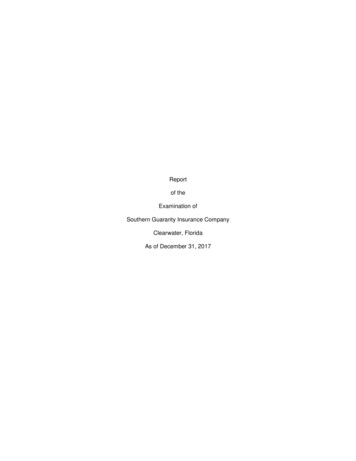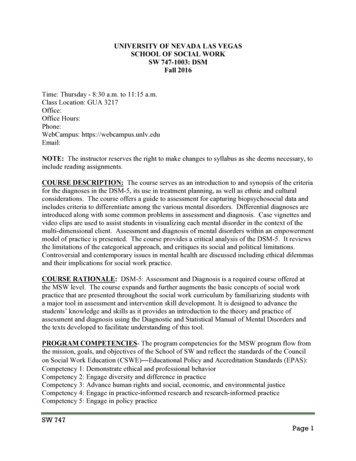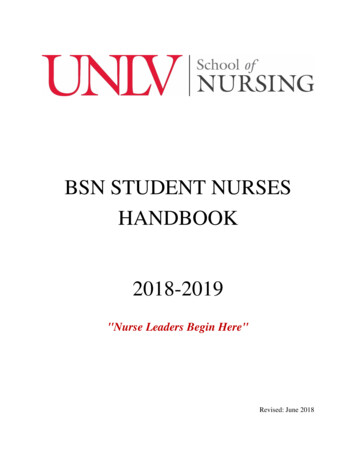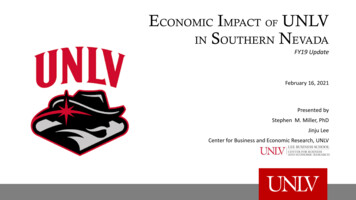
Transcription
ECONOMIC IMPACT OF UNLVIN SOUTHERN NEVADAFY19 UpdateFebruary 16, 2021Presented byStephen M. Miller, PhDJinju LeeCenter for Business and Economic Research, UNLV
UNIVERSITY OF NEVADA,LAS VEGAS (UNLV) Founded in 1957. Rapidly transformed into an urban researchinstitution along with Las Vegas’s dramatic growthin population and economic activity. The only graduate research university in SouthernNevada. The first and largest Tier 1 institution in the NevadaSystem of Higher Education. Located less than two miles east of the Las VegasStrip.2
UNLV (CONTINUED)Only three schools see more than2 percent of their alumni moving to Las Vegas52.8%University of Nevada,Las Vegas7.3%7.3%Southern Utah UniversityUniversity of Nevada,Reno Employed 4,077 individuals (Oct 2019), one of thelargest employers in Clark County. 21,328 undergraduate students and 3,956graduate and professional students (FTE)matriculated during the fall 2019 semester. Recently launched the School of Medicine (SOM),which admitted its first class in fall 2017 . Estimates of about 74,000 UNLV alumni reside inSouthern Nevada as of 2020, which accounts forabout one-fifth of those who have a bachelor’sdegree or higher in the region.Source(s): Wall Street Journal3
CLARK COUNTY, WASHOE COUNTY, & NEVADA 13,112,937Median household income ( )62,10771,88163,276Income per capita ( )48,80663,36051,161Unemployment rate4.03.23.9Less than high school graduate13.7%11.3%13.1%High school graduate28.2%22.5%27.8%Some college or associate degree32.5%34.7%33.4%Bachelor's degree or higher25.6%31.5%25.7%Population15.1%Educational attainment level (Population 25 and older)Source(s): U.S. Bureau of Economic Analysis; U.S. Census Bureau American Community Survey, 2019, 1-year estimate; Nevada State Demographer.44
CLARK COUNTY AND UNLV The Clark County economy has tried to becomemore diversified, but there has not been muchimprovement. The Great Recession affected UNLV, and now theCOVID-19 pandemic recession causes significantdisruptions. UNLV initiated a plan to become a top-tierinstitution by 2025, which will contribute to thediversification of the Southern Nevada economy.Source(s): U.S. Census; U.S. Bureau of Economic Analysis; UNLV6
UNLV AS A TOP TIER UNIVERSITY UNLV initiated a plan to become a top-tier institution by 2025 in research, education, and community impact. Top Tier not only includes research (R1) but also includes student success, an established and functioning academichealth center, reciprocal community relations, improved infrastructure, and shared governance. UNLV is a R1 institution.7
ABOUT THE STUDY Every two years, CBER conducts economic impact analysis of UNLV in Southern Nevada (Clark County, NV). Estimate UNLV’s contributions to Southern Nevada in FY 2019. Also, estimate the economic impact of UNLV on the local economy in 2025 as a top tier university.8
HOW THE ANALYSIS WAS DONE The primary effects, defined as UNLV’s direct financial contribution to local economic activity. These include: University expenditures, Student expenditures, and Visitor expenditures. The multiplier effects, which result from the additional rounds of spending. Used REMI PI v2.4 (updated with the latest national-level data sent by REMI 2020 SEP).9
PRIMARY EFFECTS:UNIVERSITY EXPENDITURE UNLV’s largest impact on the Southern Nevada economyoriginates from its spending on payroll (employee compensationand benefits) and on goods and services (utilities, services andequipment supplies). Assumed 85 percent of the university’s spending on goods andservices remained within Clark County. We also excluded thewages of graduate assistants. Thus, we estimated 139 million of 164 million were spent forgoods and services, and 512 million were spent for employees’compensation. As a part of UNLV SOM’s expenditure wasn’t included in theoperating expenditures, we added 37.5 million, which wasomitted.Source(s): University of Nevada, Las Vegas, Financial Report (unaudited), June 30, 201910
PRIMARY EFFECTS:STUDENT EXPENDITURE Only spending from 68.7% of UNLV students(16,948) was included (conservative approach). Used the student cost estimates from the UNLVfinancial aid and scholarships office. Excluded room and board expenditure forundergraduate living in campus housing. Assumed half of undergraduates are living withparents.11
PRIMARY EFFECTS:VISITOR EXPENDITURE UNLV is located less than 2 miles east from Las Vegas Strip. Has Cox Pavilion, Sam Boyd Stadium, and Thomas & Mac Center ( Allegiant Stadium for UNLV football games from 2020). More than one million attendance. Assumed 15% of all university-related event attendees and 80% ofall other event attendees were from out of town (Total 576,000attendance) . Adjusted the estimate of average per-visitor, per-trip spendingfrom the Las Vegas Convention and Visitors Authority (LVCVA) to 1,109. Spending on shows and entertainment was NOT included. Also, adjusted the visitor’s spending for the attendance atmultiple-day events to prevent potential double counting.Source(s): UNLV12
TOTAL ESTIMATED PRIMARY IMPACT OF UNLV13
TOTAL ESTIMATED Economic IMPACT OF UNLV14
UNLV AS A TOP TIER UNIVERSITY UNLV initiated a plan to become a top-tier institution by 2025 in research, education, and community impact. UNLV plans to increase its enrollments by 9.1 percent and plans to hire an additional 293 employees by 2025, whichwill decrease the student-faculty ratio from 21:1 to 20:1. In addition, UNLV SOM plans to expand to meet local health demands. The employment expects to grow 25-50 percentor more by 2030. It also plans to expand the class size once the new building construction is completed.15
213UNLV AS A TOP TIER UNIVERSITY(CONTINUED) – UNLV’S INCREMENTAL 0900980907070061Jobs (employment)2019 millions (output)1,500178190 CBER assumed that the UNLV SOM employment will have a37.5 percent increase by 2030. UNLV’s enrollments will increase by 9.1 percent to 26,565 FTEstudents. UNLV’s additional spending (excluding UNLV SOM) isestimated to be 53 million by 2025 due to the top-tierinitiative. Overall, this extra spending will bring an additional 213million to the community, which will generate 1,500 jobs mploymentNote: Additional direct spending due to the top-tier initiative and the expansion of the SOM by 2025 wasestimated with the provided information. We use linear interpolations except for additional studentspending, whereby projections were provided for each year, and put the numbers into the REMI model.Therefore, the projections for 2021 and 2022 might not reflect the current situation with limited/reducedbudgets due to COVID-19.16
UNLV AS A TOP TIER UNIVERSITY (CONTINUED) – REMI SIMULATION The table shows the impact due to the direct spending of UNLV. The output does not necessarily sum to FY19 economic output and additionaloutput increases due to the top-tier initiative and the expansion of UNLV SOM, since REMI forecasts for economic variables from 2020-2025differ from ones in 2019. This occurs because REMI is a “dynamic” economic model not a “static” model.17
UNLV AS A TOP TIER UNIVERSITY (CONTINUED)18
UNLV ALUMNI IMPACT Among 126,194 living graduates, 73,949 alumni or 58.6 percentlive in Clark County. These alumni contribute their talents invarious areas as K-12 teachers, hotel and tourism professionals,health care professionals, business owners and managers.We roughly estimate that about one fifth of the workforce thathold a bachelor’s degree or higher in Clark County received thatdegree from UNLV.During FY 2019, UNLV conferred 5,427 degrees to 5,185individuals. 86.5 percent of graduates live in Southern Nevadaand contribute to the local economy with incremental earningpower from their UNLV degrees.Number ofgraduatesPercentNevada77,43861.4Clark County, a2,7892.2Washington2,7602.2Utah2,0471.6UNLV produced 129,340 alumni over the past 55 years19
UNLV ALUMNI IMPACT (CONTINUED) – FY19 GRADUATESEconomic Impacts of Incremental Wages andSalaries by FY 2019 Graduates in Clark County990909225.8221.6230.4198.0181.8166.8103.6 50,000246.2518834 100,0001,1521,231Average1,129Cumulative output 150,0001,108Average Wages and Salaries by Age GroupIn Nevada 200,000 024-2930-34High school 2049-532054-58DoctoralWe estimate that FY19 Graduates can contribute an additional 7.9 billion of economic output over a 40-year period, which equals about an annual averageof 196.8 million.Source(s): 2014-2018 American community Survey 5-year Public Use Microdata (PUMS); CBER20
QUALITATIVE IMPACTS OF UNLV UNLV Harry Reid Research and Technology Park UNLV Community Service Beyond just “Highly Skilled” Workforce5.76.06.36.56.76.8Economic Impact of UNLV Student Volunteersvia Service-Learning CoursesFY2020*FY2021FY2022FY2023FY2024FY2025Note: The graph shows the economic output of community engagement due to servicelearning courses. FY2020 shows actual hours of service/economic output, while the rest ofyears indicate the goals of service hours /economic outputs based on the goals. Output ispresented in millions of fixed 2019 dollars.21
CONCLUSIONS UNLV generated a total of 2,445 million of economic impact in the Southern Nevada during 2019. UNLV’s Economic Impact Ratio for 2019 was 10.3. That is, for every dollar of state appropriation, the universitygenerated an additional 10.3 in economic activity in Southern Nevada. By 2025, UNLV, as a top-tier university, will generate roughly 2,705 million of economic activity, which will supportnearly 19,500 jobs in the valley. This does NOT include the numerous positive qualitative or alumni impacts of UNLV on Southern Nevada22
Knowledgewithin ReachCBERhttp://cber.unlv.edu23
UNLV’s largest impact on the Southern Nevada economy originates from its spending on payroll (employee compensation and benefits) and on goods and services (utilities, services and equipment supplies). Assumed 85 percent of the university’s spending on goods and se
